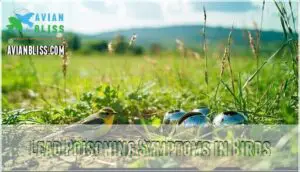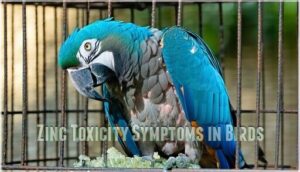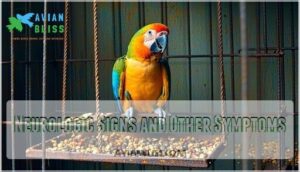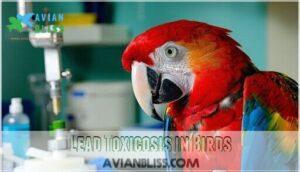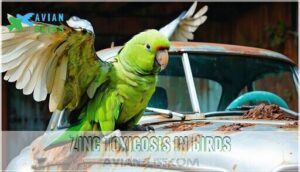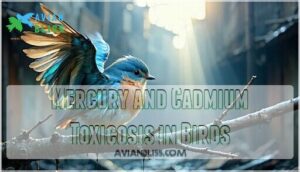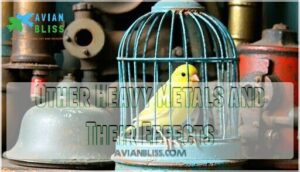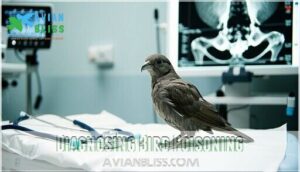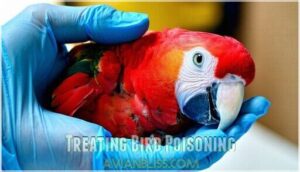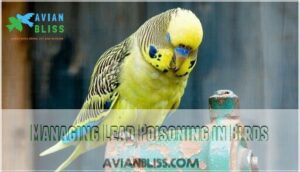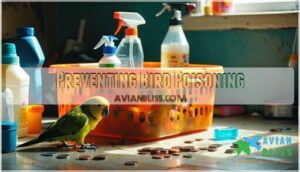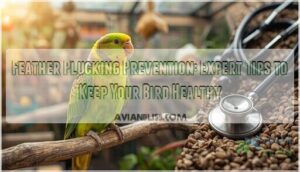This site is supported by our readers. We may earn a commission, at no cost to you, if you purchase through links.
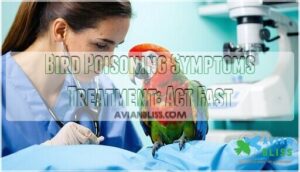
If you suspect your bird has ingested something toxic, look out for symptoms like constant thirst, regurgitation, and listlessness.
For effective bird poisoning symptoms treatment, get your bird to a vet ASAP, as they’ll likely use chelates to detoxify the poisonous metal agents.
You’ll want to know more about the treatment process and how to prevent future incidents, so let’s take a closer look at what you can do to save your feathered friend.
Table Of Contents
- Key Takeaways
- Identifying Bird Poisoning Symptoms
- Types of Heavy Metals in Bird Poisoning
- Diagnosing Bird Poisoning
- Treating Bird Poisoning
- Managing Lead Poisoning in Birds
- Preventing Bird Poisoning
- Aftercare and Recovery
- Frequently Asked Questions (FAQs)
- What should I do if my bird is poisoned?
- How do you know if a bird is poisoned?
- How do you know if a bird is poisoned by PTFE?
- What are the signs of lead toxicosis in birds?
- What are the symptoms of chemical poisoning in birds?
- What happens if a bird is poisoned?
- How to treat a poisoned bird?
- What are the symptoms of bird poisoning?
- How do you treat a poisonous bird?
- How is lead toxicosis treated in birds?
- Conclusion
Key Takeaways
- You’ll need to act fast if you suspect your bird has ingested something toxic, as prompt treatment is essential for recovery, and you should get your bird to a vet ASAP.
- You can identify bird poisoning symptoms by looking out for changes in droppings, lethargy, coordination issues, or unusual behavior, and checking for signs like tremors, seizures, or breathing difficulties.
- Common causes of bird poisoning include heavy metals like lead and zinc, aerosol sprays, toxic foods, and toxic plants, so you’ll want to remove these hazards from your home to prevent poisoning.
- To treat a poisoned bird, you’ll need to provide supportive care, remove the toxin source, and seek immediate veterinary attention, where they may administer chelation therapy, fluids, and other treatments to help your bird recover.
Identifying Bird Poisoning Symptoms
You’ll need to identify the symptoms of bird poisoning quickly to act fast and save your bird’s life.
Act fast to save your bird’s life from poisoning
By recognizing common signs like changes in droppings, lethargy, or coordination issues, you can take immediate action to help your bird recover from poisoning.
Common Causes of Bird Poisoning
Your home can be full of hidden dangers for your feathered friend. Many household hazards can cause bird poisoning symptoms.
Here are some common bird poisoning causes:
- Heavy Metals: Lead and zinc in old paint or cages.
- Aerosol Sprays: Air fresheners and cleaning products.
- Toxic Foods: Avocado, caffeine, and chocolate.
- Toxic Plants: Lilies, azaleas, and mistletoe.
- Household Toxins: Cleaning products and pesticides.
Watch out for these toxic substances birds can get into. Bird-proof your home to prevent heavy metal poisoning.
Lead Poisoning Symptoms in Birds
You must recognize lead poisoning symptoms in birds, including:
- Weakness
- Lethargy
- Loss of appetite
- Tremors
Early detection is essential for successful treatment, as chronic lead exposure can cause neurological deficits.
Identify the lead source to prevent further poisoning and consider chelation therapy to address lead poisoning effects.
Birds are also susceptible to aerosol toxin inhalation.
Zinc Toxicity Symptoms in Birds
You’ll notice zinc toxicity symptoms in birds, such as weight loss and appetite changes.
A common culprit is newly galvanized wire.
| Zinc Sources | Dropping Changes | Feather Changes |
|---|---|---|
| Galvanized wire | Greenish color | Ruffled feathers |
| Linoleum | Loose droppings | Feather plucking |
| Pennies | Blood in droppings | Loss of feathers |
The symptoms can be identified by changes in droppings and feather condition, which are critical indicators of zinc poisoning.
Neurologic Signs and Other Symptoms
After spotting zinc toxicity, watch for neurological signs. Bird poisoning symptoms can show up as muscle twitching or a stiffened neck.
You might see seizures, weakness, or paralysis. These avian toxicity signs are serious. Don’t ignore respiratory distress or dropping changes. Sudden energy loss is another red flag.
If you see these symptoms, get help fast!
- Act quickly.
- Don’t delay.
- Get help now.
Types of Heavy Metals in Bird Poisoning
You’ll need to know the types of heavy metals that can poison your bird, including lead, zinc, and mercury.
Understanding these metals and their effects is essential for providing the right treatment and care for your poisoned bird.
Lead Toxicosis in Birds
As you care for your bird, beware of lead sources, which can cause lead poisoning, a form of heavy metal poisoning.
Chelation therapy can aid in treatment, but prevention strategies are key to avoiding neurological damage and long-term effects, ensuring successful bird poisoning treatment and chelation success.
Zinc Toxicosis in Birds
You can save your bird from zinc toxicosis by:
- Avoiding toxic cage materials
- Monitoring zinc sources
- Recognizing gastrointestinal effects, a sign of zinc toxicity and heavy metal poisoning, to provide timely poisoned bird treatment, including chelation therapy.
Mercury and Cadmium Toxicosis in Birds
You face mercury and cadmium toxicity, found in batteries and pollutants, causing weakness and neurological issues in birds.
Requiring immediate attention and treatment options like chelation therapy to prevent heavy metals toxicity.
Other Heavy Metals and Their Effects
You’ve learned about mercury effects and cadmium poisoning. Other heavy metals can also harm your feathered friend. Think of it like this: your bird’s health is a delicate ecosystem. Exposure to these heavy metals disrupts that balance.
Here are some other culprits to watch out for:
- Copper toxicity causes liver damage.
- Arsenic exposure leads to digestive upset.
- Manganese impacts the nervous system.
- Iron overload causes organ damage.
Early detection of bird poisoning symptoms is key! If you notice anything unusual, seek supportive care. Chelation therapy might be needed. Remember, acting fast can make all the difference with zinc toxicity and other heavy metals.
Diagnosing Bird Poisoning
You’ll need to identify the symptoms of bird poisoning and take action quickly to save your bird’s life.
By recognizing the signs and using diagnostic tools like radiographs and blood tests, you can help your vet determine the best course of treatment for your poisoned bird.
Radiographs and Imaging
You’ll use radiographs to detect metal and imaging abnormalities, aiding in bird poisoning diagnosis.
Detect metal poisoning with radiographs for accurate bird diagnosis
Techniques like plain X-ray, contrast X-ray, and CT scans help pinpoint trouble, providing a detailed look at avian anatomy and metal detection for accurate diagnosis of bird toxin exposure, specifically bird poisoning.
Serum Zinc and Blood Lead Levels
You’re diagnosing bird poisoning.
Testing for serum zinc and blood lead levels helps. Accurate results rely on proper sample collection and interpretation.
Reference ranges guide treatment, especially for lead and zinc poisoning, informing chelation therapy and ensuring the best care for your bird.
Atomic Absorption Spectrophotometry
You’ll find atomic absorption spectrophotometry useful for diagnosing bird poisoning.
It offers:
- Accuracy in heavy metal detection
- Sensitivity to small amounts
- Reliable results for treatment and diagnosis of toxic substances in birds.
History, Clinical Signs, and Laboratory Results
You play detective, gathering clues from your bird’s history, clinical signs, and lab results to diagnose poisoning.
Historical exposure, initial symptoms, and diagnostic testing reveal metal identification and chronic effects, guiding bird poisoning diagnosis and treatment, using blood tests and radiographs.
Treating Bird Poisoning
You’ll need to act quickly when treating bird poisoning, as prompt care can substantially improve your bird’s chances of recovery.
By providing stabilization, supportive care, and removing the source of the toxin, you can help your bird recover from poisoning.
Stabilization and Supportive Care
You’re now focused on stabilization and supportive care for bird poisoning.
This involves fluid therapy, temperature regulation, nutritional support, and sometimes pain management, all aimed at giving your bird a fighting chance at recovery through proper supportive care measures.
Chelation Therapy and Anticonvulsants
You’ll use chelation therapy to safely remove heavy metals.
Anticonvulsants manage seizures, so monitor dosage and side-effects.
Chelation therapy binds metals, helping them exit the body, while anticonvulsants calm neurological signs, aiding treatment under veterinary intervention.
Many common products cause aerosol poisoning in birds, which can be managed with anticonvulsants and understood through veterinary intervention.
Removing The Source of Heavy Metal Exposure
You’re a bird parent on a mission.
Remove lead hazards, analyze toy composition, and guarantee cage material safety to prevent lead poisoning.
Identify galvanized wire risks and control industrial pollutants to create a safe haven, vital after chelation therapy, to protect your feathered friend from heavy metals.
Regular use of a lead detection kit can help identify these hazards.
Medications and Dosage
Once you’ve removed the source, getting the right medications is essential. Chelation therapy helps flush out metals. Watch for side effects. Dosage adjustments might be needed. Keep an eye on drug interactions. Fluid therapy and nutritional support are also key.
Treatment duration varies. Stay in touch with your vet. Veterinary intervention is key.
What could happen if we don’t act fast?
- Your feathered friend’s suffering.
- A missed chance for recovery.
- Unnecessary heartache.
Managing Lead Poisoning in Birds
You’ll need to act quickly if you suspect your bird has lead poisoning, as prompt treatment is essential for recovery.
By understanding the symptoms, diagnosis, and treatment options, you can help manage lead poisoning in your bird and prevent further exposure to this toxic metal.
Lead Poisoning Symptoms and Diagnosis
You’re now dealing with lead poisoning.
Watch for:
- Weakness
- Dropping changes
- Neurologic symptoms, indicating lead toxicity from metal particles, a sign of acute or chronic lead poisoning, requiring immediate blood tests to diagnose symptoms.
Chelation Therapy for Lead Poisoning
When treating lead poisoning, you’ll consider chelation therapy, which binds lead to agents like DMSA or EDTA.
| Chelation Effectiveness | Therapy Side-Effects |
|---|---|
| High | Low |
| Medium | Medium |
| Low | High |
This method has pros and cons, including dosage considerations and alternative therapies, to help your bird recover from lead poisoning.
Supportive Care and Hospitalization
Act quickly if you suspect lead poisoning.
You’ll need to provide supportive care, including:
- Fluid therapy
- Nutritional support
- Quiet environment, to stabilize your bird, with veterinary intervention for bird poisoning treatment options.
Preventing Lead Exposure in Birds
Create a lead-free environment with lead-safe toys and paint alternatives.
Supervise foraging, verify water source safety, and use lead testing kits to prevent lead poisoning, promoting a safe and healthy space for your birds to thrive in a leadsafe and heavy metal poisoning recovery-friendly setting.
Be aware that household aerosols are deadly to birds due to their sensitive respiratory systems, making a healthy space crucial.
Preventing Bird Poisoning
You can prevent bird poisoning by removing household hazards and using safe toys and accessories.
By supervising your birds and taking steps to prevent exposure, you can help keep them safe from toxic substances and heavy metals, which is crucial for their well-being and safety.
Common Household Hazards for Birds
You’re protecting your bird from harm.
Watch out for toxic cleaning products, Teflon cookware, and lead paint risks at home.
Unsafe plants and air fresheners can also cause bird poisoning symptoms, requiring urgent veterinary care to treat household hazards and toxic substances.
Safe Toys and Accessories for Birds
When choosing bird toys, consider Material Safety and Toy Design.
For safe play, opt for:
- birdsafe toys
- leadfree toys
- nontoxic materials
Selecting appropriate toys includes purchasing certified safe options.
Guarantee bird toy safety with supervised play and safe chew toys.
Supervising Birds and Preventing Exposure
With bird toy safety in mind, you can start building a bird safe environment for your feathered friends.
For many bird-safe toy options, check online stores.
Here’s how to keep your bird safe:
- Are there household hazards?
- Is your bird’s area tidy?
- Are you watching your bird closely outside?
- Do you check for risks at home?
For bird poisoning prevention, always watch your birds. Bird-proofing homes means keeping toxic plants and cleaning products away. Use natural alternatives. Supervise safe foraging. A birdproof home is a happy home.
Removing Lead Sources From The Environment
It’s key to remove lead sources from your bird’s world. Check for old paint and lead trinkets. Use lead-safe toys. Bird-proof your home to protect your feathered friend.
Addressing contaminated water sources is also vital for preventing illness.
:
——————–
:
——————–
Regular Environment Monitoring and Toy Safety checks are essential. Make Safe Foraging without lead poisoning risks a priority.
Aftercare and Recovery
You’ll need to provide the right care to help your bird recover from poisoning.
By monitoring their progress, managing symptoms, and providing nutritional support, you can help your bird heal and get back to their normal self, which involves careful management of their condition.
Monitoring Progress and Adjusting Treatment
You’re guiding your bird’s recovery.
Monitor blood lead levels, chelator effectiveness, and adjust doses as needed.
Consider:
- Tracking bird longterm monitoring
- Watching for bird behavior changes
- Noting bird recovery timeline
to prevent Symptom Reoccurrence and support immune response, ensuring your bird returns to its chirpy self.
Managing Neurologic Signs and Other Symptoms
You manage neurological signs like seizures and tremors with seizure control and fluid therapy, addressing bird distress signs and symptoms to guarantee recovery.
Focusing on nutritional support and monitoring dropping changes, all vital for treating bird seizures and symptoms, and alleviating respiratory distress and other neurological signs, is crucial with fluid therapy.
Providing Nutritional Support and Care
To support your bird’s recovery, focus on a balanced diet and safe foraging.
Develop a recovery diet with supportive feeding and hydration protocols. A nourishing diet is essential, so consider supplementation needs and appetite stimulation.
Provide a bird recovery diet with proper hydration methods to meet their nutritional needs, aiding in their overall bird supportive therapy.
You can find a specialized diet here to help your bird recover with a recovery diet.
Follow-up Consultations and Long-term Care
As we shift from bird supportive therapy, remember that aftercare is ongoing.
Think of it as tending a garden.
Long-term care involves monitoring behavioral changes and dietary adjustments.
You might need bird recovery supplements.
Environmental enrichment is essential for Relapse prevention.
Follow-up consultations with avian veterinarian services will guide you through this delicate phase.
It guarantees medication management and your feathered friend’s chirpy self!
- Assess progress.
- Adjust treatment.
- Longterm care.
Frequently Asked Questions (FAQs)
What should I do if my bird is poisoned?
Oh no, your feathered friend is in trouble! Immediately remove the toxin source, flush affected areas, and rush to a vet for life-saving treatment and care.
How do you know if a bird is poisoned?
You’ll know if a bird is poisoned by looking for changes in droppings, lethargy, coordination issues, or unusual behavior, and checking for signs like tremors, seizures, or breathing difficulties.
How do you know if a bird is poisoned by PTFE?
You’ll notice symptoms like seizures, tremors, or respiratory distress if your bird is poisoned by PTFE, also known as Teflon, often caused by heated non-stick cookware.
What are the signs of lead toxicosis in birds?
You’re a detective, and lead toxicosis is the culprit. Look for vomiting, diarrhea, lethargy, blindness, tremors, and convulsions as telling signs that your bird has been poisoned.
What are the symptoms of chemical poisoning in birds?
You’ll see symptoms like vomiting, diarrhea, lethargy, and tremors in birds exposed to chemicals, indicating a potentially life-threatening situation requiring immediate veterinary attention.
What happens if a bird is poisoned?
If a bird is poisoned, you’ll likely notice severe symptoms like vomiting, seizures, or breathing issues, requiring immediate veterinary care to prevent further harm or even death.
How to treat a poisoned bird?
A million things are racing through your mind, but you must act fast: rush the bird to a vet, provide a safe space, and follow their treatment instructions carefully.
What are the symptoms of bird poisoning?
You’ll notice symptoms like lethargy, vomiting, diarrhea, tremors, and seizures in a poisoned bird, indicating serious health issues that require immediate attention and veterinary care.
How do you treat a poisonous bird?
You’ll need to provide supportive care, remove the toxin source, and seek immediate veterinary attention to treat a poisoned bird, administering fluids and chelation therapy as prescribed.
How is lead toxicosis treated in birds?
You’ll treat lead toxicosis with chelation therapy, fluid administration, and oxygen therapy, under veterinary guidance, to remove lead from the bird’s system and manage symptoms.
Conclusion
You’ve learned about bird poisoning symptoms treatment, now act fast.
Notably, many birds die from poisoning each year.
You’ll effectively treat your bird by recognizing bird poisoning symptoms treatment and getting them to a vet quickly, they’ll use chelates to detoxify, saving your feathered friend with proper treatment.


